In early June, American astronomers unveiled plans for the construction of the next-generation radio telescope, which could partially replace the legendary Arecibo Observatory which collapsed on December 1, 2020. In this article, we explore the key discoveries made at Arecibo and why it held a special place in modern science.
The Creation of Arecibo
The idea of creating the world’s largest radio telescope was championed since 1958 by Professor William Gordon of Cornell University. It was he who conceived the concept of “embedding” a spherical antenna in a natural depression of corresponding shape and size. Initially, the main reflector of the instrument was planned to have a diameter of 492 feet (150 meters) and be adapted for atmospheric studies. The receiving and transmitting equipment was to be installed on a tower over 100 meters high. However, later on, the project caught the interest of astronomers. Eventually, the antenna was doubled in size, and the electronic equipment was suspended above it on a movable platform, allowing for pointing to different parts of the sky within the declination range of +40° to -2°. “Pointing” by direct elevation was supposed to be provided by the axial rotation of our planet.
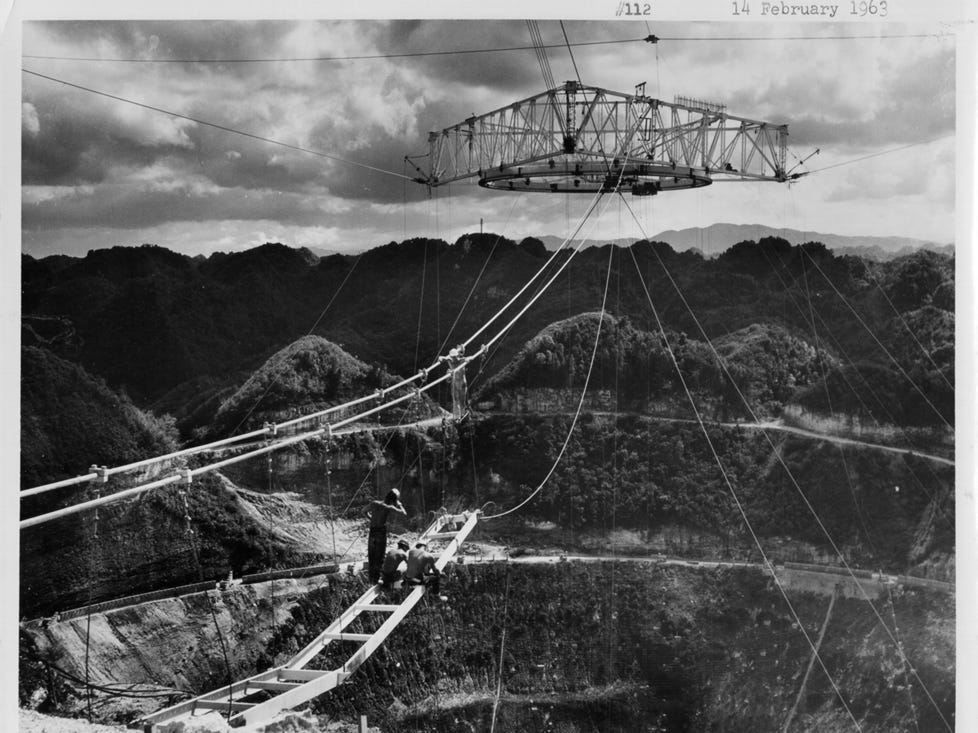
The search for the best location to build the giant instrument took nearly two years. On the one hand, it was desirable to position it closer to the equator for better coverage of the celestial sphere. On the other hand, the country or territory where it was to be built needed to experience minimal natural disasters, have a stable political regime, and maintain friendly relations with the United States. Eventually, the choice was made in favor of the Caribbean island state of Puerto Rico, where a suitable karst sinkhole was found near the town of Arecibo.
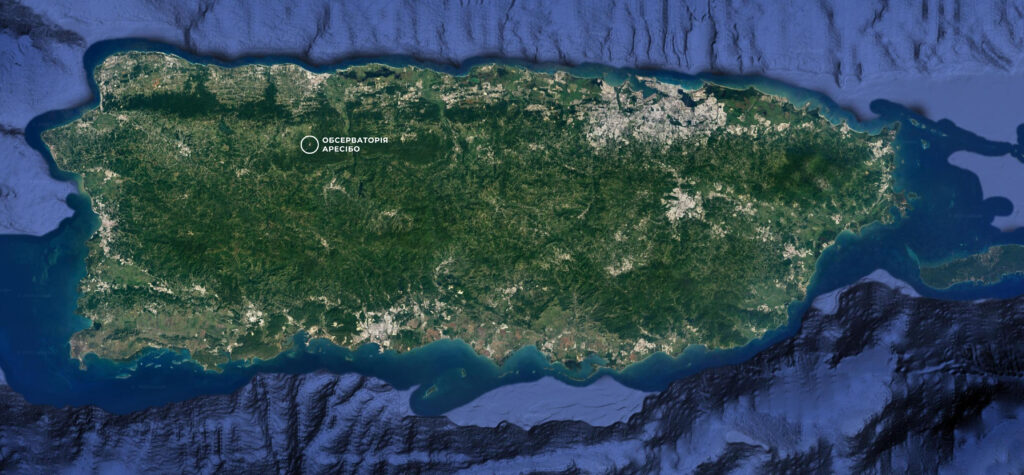
Construction of the observatory began in 1960, and on November 1, 1963, it “saw first light,” as they say. The new radio telescope became a symbol of technological progress and surpassed its time in many ways. For the first six months, it was entirely «occupied» by the military, who also contributed to its funding and actively used it for experiments in national defense. However, a civilian director was appointed for Arecibo — William Gordon himself — who held the position until 1965. Scientists began to participate in observations, and in April 1964, the first astronomical discovery was made at Arecibo.
Major Achievements of Arecibo
Mercury’s Rotation Period. The early 1960s marked the beginning of experimental radiolocation of planets, and the Earth’s largest antenna could not stay aloof. Radar investigations of Mercury revealed that its rotation period around its axis did not correspond to its orbital period (88 Earth days) but was significantly shorter (59 days). At the time, this discovery may not have seemed as significant as it does today, but it served as substantial evidence of Arecibo’s effectiveness.

Pulsars and Exoplanets. In 1967, the first pulsars, a new class of astronomical objects, were discovered. According to modern understanding, they are the “remnants” of massive stars after the exhaustion of thermonuclear fusion reactions based on hydrogen and helium in their cores. The Arecibo Observatory was subsequently used extensively for pulsar research, which not only shed light on the stellar evolution of massive stars but also provided confirmation of Einstein’s General Theory of Relativity.
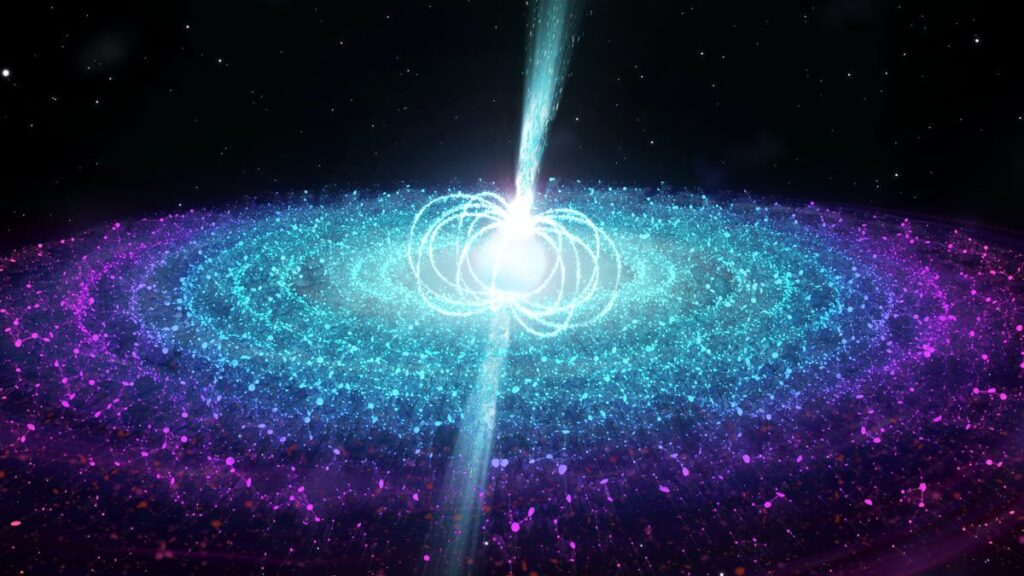
In 1991, a Polish astronomer Aleksander Wolszczan, who was a staff member of the observatory, noticed periodic changes in the pulsar B1257+12 and hypothesized that three planet-like bodies orbiting the remains of a dead star were causing these changes. This discovery marked the first detection of planets outside the Solar System. Later, these planets were named “Draugr,” “Phobetor,” and “Poltergeist.”
“The Arecibo Message”. Since 1971, the observatory came under the management of the National Science Foundation (NSF), which funded a major reconstruction of the telescope in 1974. The wire mesh of the reflector was replaced with perforated aluminum plates, and new receiving equipment and a 420 kW radar were installed, emitting pulses at a frequency of 2.4 GHz. This allowed for effective research on asteroids and nuclei of comets approaching Earth, as well as the creation of the first radar map of Venus’ surface. In 1974, a radio message containing basic information about Earth and human civilization was transmitted towards the star cluster M13 in the constellation Hercules. It is often referred to as the first attempt to communicate with extraterrestrial intelligence, although scientists understood that the message would only reach its destination in 22,000 years. The main purpose of the message was to demonstrate the technical capabilities of the upgraded instrument.
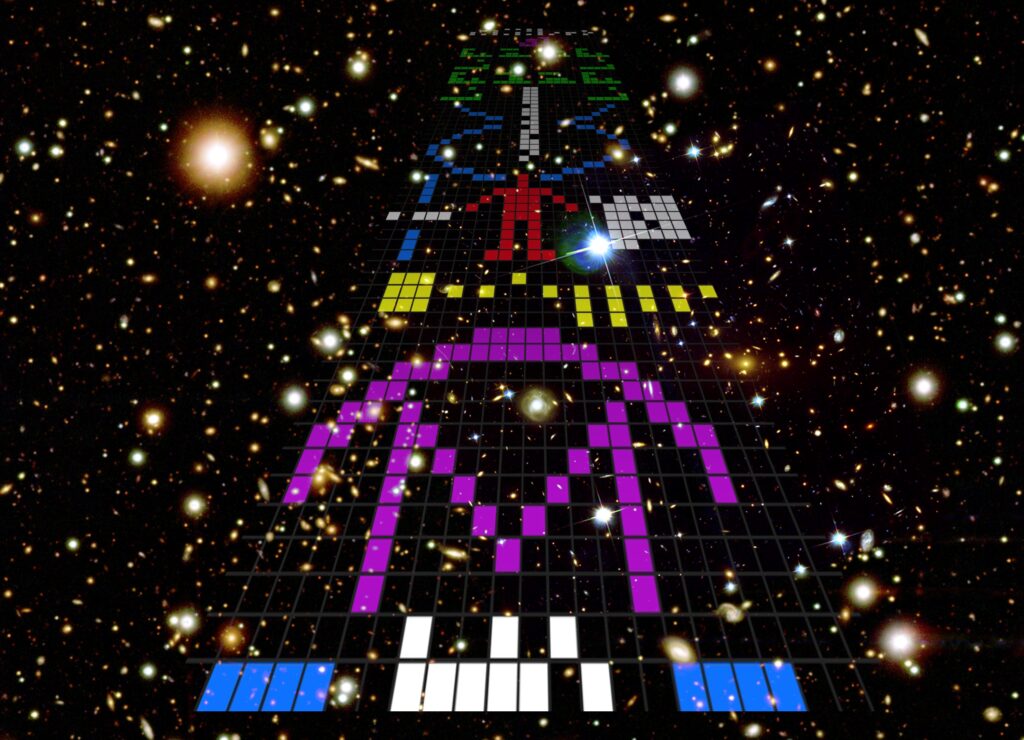
The Distant Universe. In the late 1970s, the Arecibo telescope helped find evidence of dark matter — a mysterious component of the world that does not absorb or emit electromagnetic waves and reveals its presence only through gravitational influence on visible matter. The nature of this matter is currently only conjecture in the scientific community. In the early 80s, based on data obtained by the largest radio observatory, astronomers built the first model of the three-dimensional structure of the Universe, which is a huge “web” with clusters of galaxies and intergalactic gas near the intersection of individual “tissue” of the web.
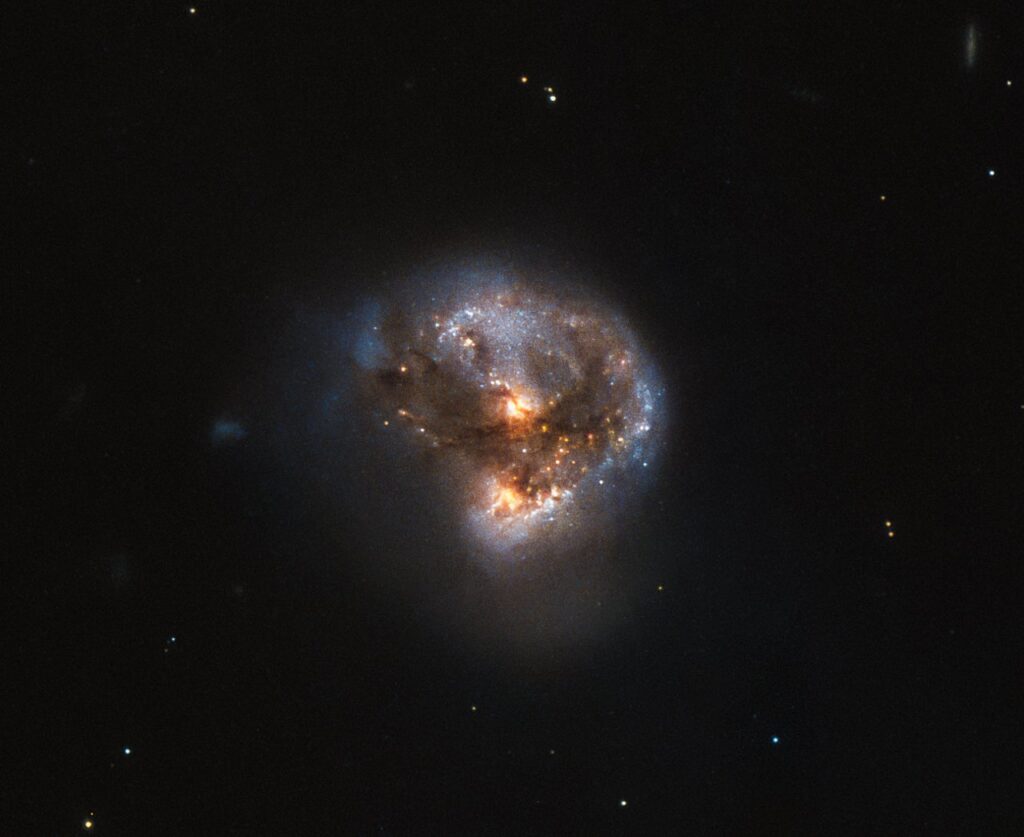
In 1982, this unique instrument discovered the first hydroxyl megamasers in regions of active star formation and in other galaxies. These megamasers are powerful sources of radio emission in narrow spectral lines of the hydroxyl radical OH (at 1612 and 1665 MHz). They have been instrumental in measuring interstellar distances and studying stellar evolution processes.
Other Discoveries in the Solar System. Arecibo regularly used its antenna for radar observations of near-Earth asteroids and some objects in the main asteroid belt. This allowed scientists to determine their shape, surface properties, and rotation rates more accurately. In 2000, the radio telescope observed a binary asteroid for the first time, and in 2003, it provided evidence of liquid hydrocarbon lakes on the surface of Saturn’s moon Titan.
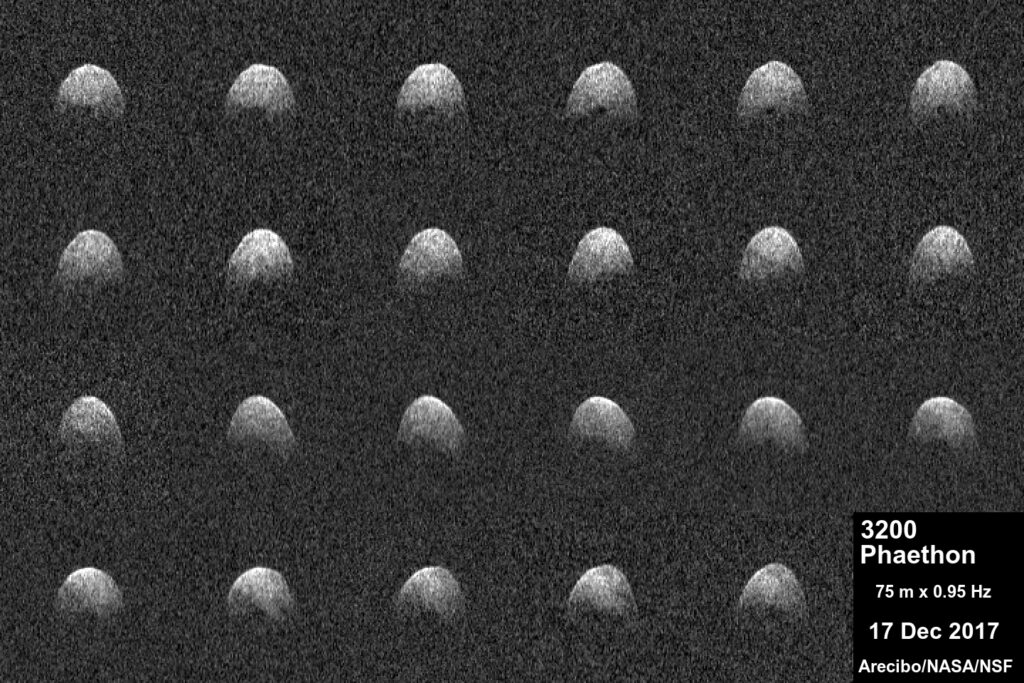
Recent Years.
The second and final renovation of the observatory took place from 1994 to 1997, costing $25 million. The radio telescope acquired an additional receiver at the Cassegrain focus (accompanied by a “secondary” suspended dome), and its frequency range was expanded. An information center for visitors was also established. In 1995, the instrument played a critical role in restoring communication with the Solar and Heliospheric Observatory (SOHO), a space-based solar telescope. Since then, SOHO has continued to operate successfully.

During the repair work in 1994, the reduced scientific workload allowed the Arecibo antenna to be used as a filming location for the final scenes of the movie “GoldenEye” (the 17th James Bond film). Later, it was featured in the science fiction films “Species” and “Contact.”
In 1999, the observatory began contributing its observation data to the distributed computing system SETI@home, which aimed to search for artificial signals among “cosmic radio noise.” Anyone could install the corresponding program on their personal computer and receive data for automatic analysis via the Internet. Therefore, Arecibo literally reached every home connected to the World Wide Web.
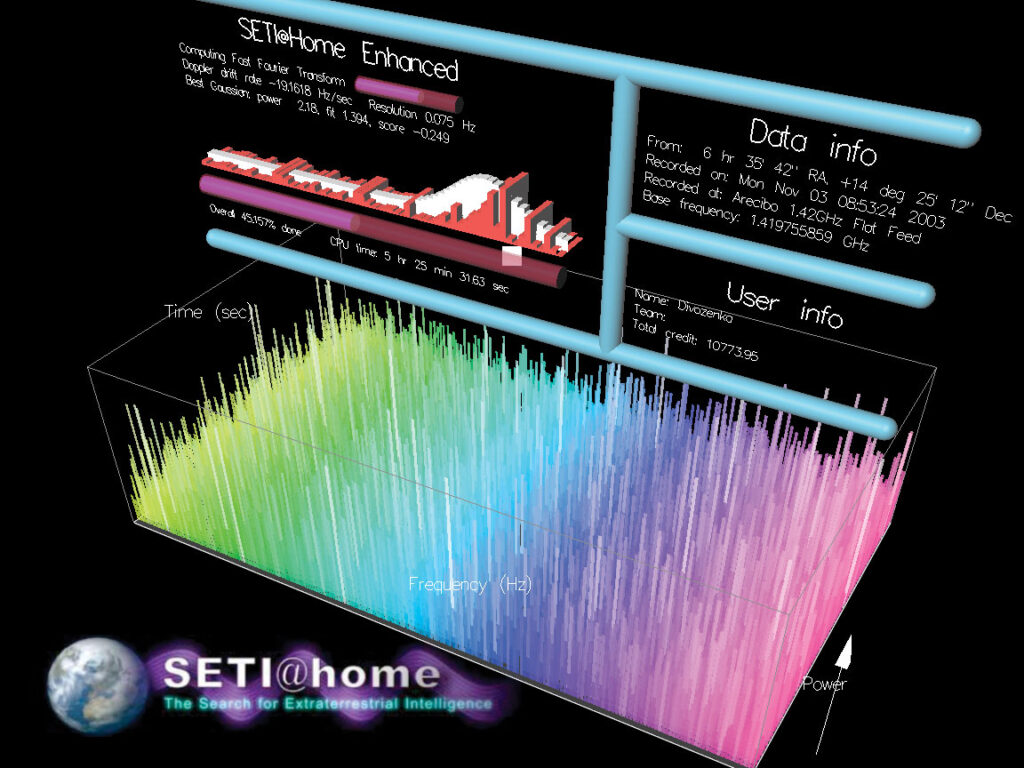
The mentioned discoveries are only a small part of all the achievements of the radio telescope, confirming its significant importance for global science. For over half a century, it remained the only instrument with a continuous aperture of such size, and only in 2016 did it pass this honorary title to the Chinese Five-hundred-meter Aperture Spherical Telescope (FAST), the final commissioning of which was completed last year.
Destruction of the Arecibo Structure
However, no matter how perfect the Arecibo Observatory was, the structural materials of the receiving and transmitting equipment complex (especially its suspension system), which were constantly under the greatest strain, gradually deteriorated, and plans for their replacement were postponed “for better financial times.” Significant problems began in September 2017 when the telescope was affected by two powerful hurricanes. While the first one (named “Irma”) did not cause critical damage, the second one — the notorious Hurricane “Maria” — tore off a 29-meter antenna from the suspension structure, causing it to fall onto the main reflector and puncture it. The auxiliary 12-meter antenna, necessary for coordinating very long baseline interferometry (VLBI) observations with other radio telescopes on the planet, was also destroyed.
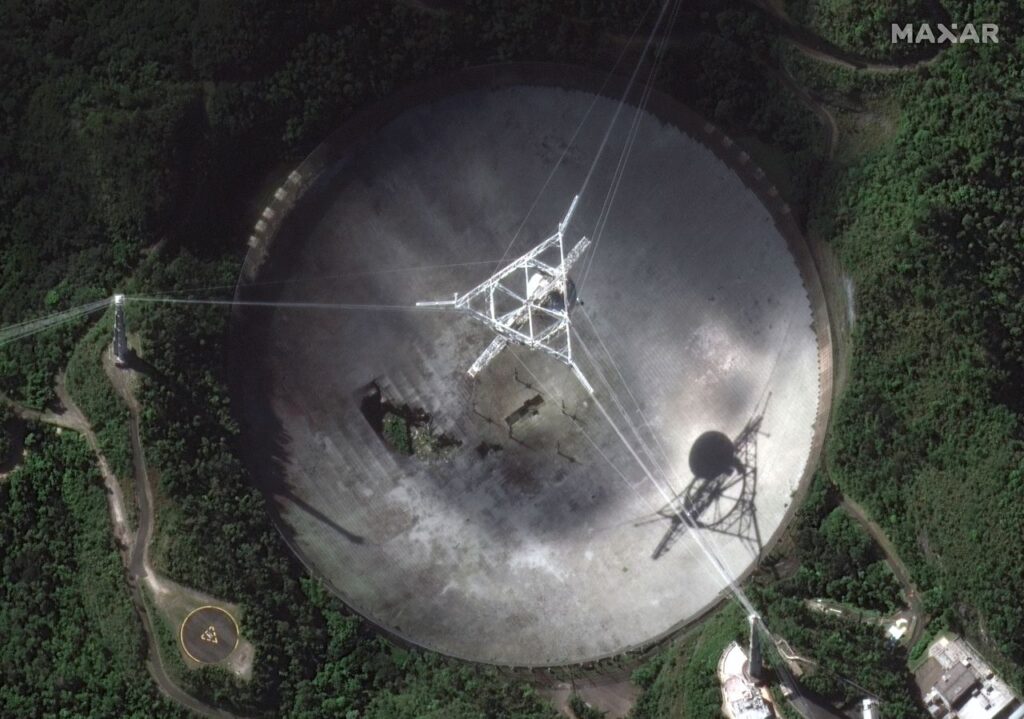
The repair of the suspended platform and its repositioning took nearly six months. In the spring of 2018, Arecibo resumed observations. In December of the same year it performed radar probing of Comet Wirtanen (46P/Wirtanen) and the asteroid (163899) 2003 SD220 during their flybys near Earth. However, a 6.5 magnitude earthquake that occurred in Puerto Rico on January 7, 2020, proved fatal for the renowned observatory. External inspections began to reveal signs of dangerous wear on the suspension system. Finally, on August 10, the first auxiliary cable attached to Tower #4 (there are three towers, numbered like the digits on a clock face, where “12” corresponds to the north) snapped. The NSF leadership decided to limit the personnel’s activity and ordered the services of an independent engineering audit to assess the overall condition of the structure.

On November 6, the second auxiliary cable snapped. By that time, the invited commissions had identified a high degree of wear on the main support cables, although the load on them did not exceed 62% of the maximum allowable. The engineering expertise conclusions stated that the loss of at least one more suspension element would trigger a chain reaction of destruction with unpredictable consequences. All staff were evacuated from the observatory and the information center, except for security personnel. On November 24, a final decision to dismantle Arecibo by controlled demolition was made during a general meeting with NSF representatives. But fate had other plans.
The End of an Era
On December 1 2020, at 8:00 a.m. local time, the cables connecting the 900-ton suspended platform to the long-suffering “Fourth Tower” gave way. The platform fell onto the northeast segment of the main antenna from 100 meters height. The tops of all three concrete support towers to which it was attached also collapsed. The Arecibo Radio Telescope ceased to exist. Fortunately, thanks to safety measures taken in advance, the catastrophe resulted in no human casualties. Currently, NSF staff are deciding what to do with the remains of the telescope. The auxiliary 12-meter antenna and the lidar (laser radar) used for atmospheric research remained in working condition. The information center suffered minimal damage, and it is likely that it will serve as a basis for a museum to commemorate the observatory. Unfortunately, it was not possible to save all scientific equipment.
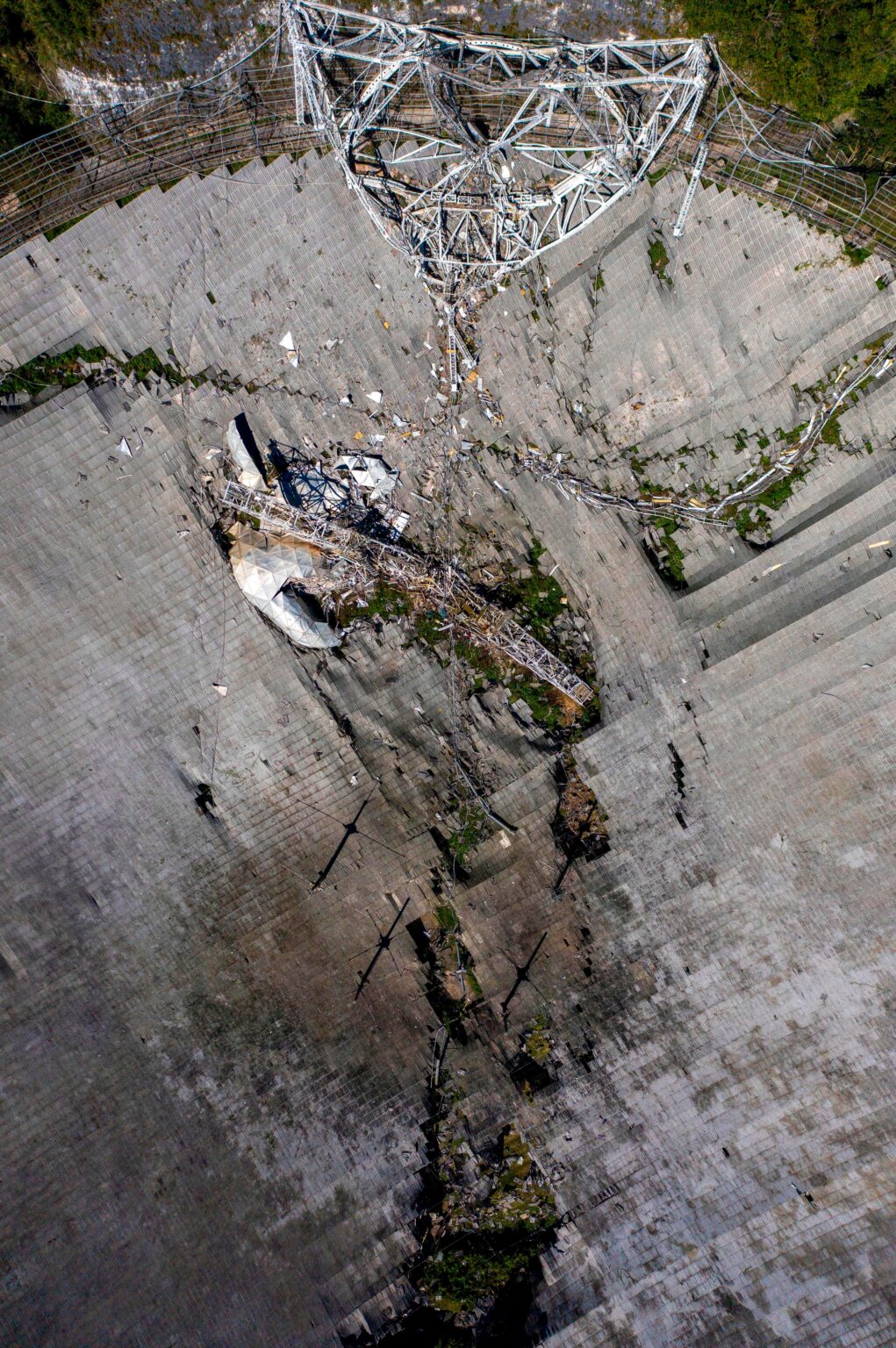
World science has irreversibly lost a highly sensitive and well-calibrated instrument for observations across a wide range of radio waves, which could have been used in experiments on celestial radio astronomy and as a component of the Very Long Baseline Interferometry (VLBI) system. Restoring it to working condition would require more effort and resources than constructing a new radio telescope with similar parameters.
After the demise of Arecibo, engineers proposed a number of ideas for restoring the complex. One of them involves rebuilding the main antenna but on a smaller scale and placing a receiver above it on the central tower, as originally planned. Another option is to construct a smaller array of numerous antennas that can be steered. We hope that at least some of these proposals can be implemented. However, it can be confidently stated that Arecibo will never operate at its full capacity again.
